Will the iPhone's rumored recurring satellite communications really make for a good signal?
Last September, on the eve of the iPhone 13 launch, there were rumors that the new iPhone was going to work with Globalstar to support satellite phones, but Cook wasn't expecting what fans were expecting. In fact, as the unnamed source quoted in the 🔗 article states, namely that while the 13's hardware may support satellite communications, the actual service is unlikely to launch within a year: the
And though the next iPhone could have the hardware needed for satellite communications, the features are unlikely to be ready before next year, said another person, who asked not to be identified because the plans aren't yet public.
Gurman notes that Apple's partner Globalstar purchased 17 new satellites in February to help provide "continuous satellite service" to a "potential" but unnamed customer who has paid it hundreds of millions of dollars. Gurman notes that Apple's partner Globalstar purchased 17 new satellites in February to help provide "continuous satellite service" to a "potential" but unnamed customer who has paid it hundreds of millions of dollars.
 In fact, the news came out of nowhere last year, back in 2017, when Bloomberg first reported Apple's keen interest and talks with Boeing about LEO satellite business. Apple has also hired aerospace company communications satellite expert Ashley Moore-Williams and former Netflix executive Daniel Ellis, and is continuing to expand its team. Apple's vast secret plans include launching its own satellites and building a satellite Internet data communications network that can only be used by itself.
In fact, the news came out of nowhere last year, back in 2017, when Bloomberg first reported Apple's keen interest and talks with Boeing about LEO satellite business. Apple has also hired aerospace company communications satellite expert Ashley Moore-Williams and former Netflix executive Daniel Ellis, and is continuing to expand its team. Apple's vast secret plans include launching its own satellites and building a satellite Internet data communications network that can only be used by itself.
News reports have since emerged that the communications research team dedicated to Apple's headquarters is led by Michael Trela and John Fenwick, with about 12 of them coming from the aerospace and satellite technology fields, including engineer Matt Ettus - one of the most prominent figures in wireless One of the most prominent figures in the technology field founded Ettus Research, a company dedicated to selling wireless networking equipment.
One year has come and gone, welcome the king of signals? So, if the iPhone, which is known for its poor signal, can really support satellite communication, will it be able to receive satellite signals in the basement?
Let's start with the conclusion: of course not.
Learn more about what a satellite phone is and who else might be partnering with Apple to provide satellite communications.
What's a satellite phone?
Satellite phone is the abbreviation of portable satellite communication system. It differs most from cellular network communications in that it is not connected to the telecommunications network through a ground-based station, but communicates directly with the communications satellites in the sky.
 Communication satellites are the medium through which satellite telephony works, receiving and relaying radio signals and amplifying them, generally using low- and medium-orbit satellite systems as satellite telephone systems. In the satellite telephone communication process, the satellite communication ground station will transform the received voice signal into a carrier signal, which will then be transmitted to the communication satellite. The space transponder on the communications satellite performs the signal energy enhancement and then transmits it to the satellite communications ground station at the other end.
Communication satellites are the medium through which satellite telephony works, receiving and relaying radio signals and amplifying them, generally using low- and medium-orbit satellite systems as satellite telephone systems. In the satellite telephone communication process, the satellite communication ground station will transform the received voice signal into a carrier signal, which will then be transmitted to the communication satellite. The space transponder on the communications satellite performs the signal energy enhancement and then transmits it to the satellite communications ground station at the other end.
What we know as GPS is a communication satellite system located in Medium Earth Orbit (MEO). The user device, such as a mobile phone, acts as a GPS receiver and receives signals from the GPS satellites and uses the incoming information to calculate the user's three-dimensional position and time. A mobile phone can only simply receive signals from GPS satellites and cannot transmit signals to satellites.
 GPS receivers while satellite phone terminals, because they are equipped with high power RF antennas, can send signals to satellites, thus enabling satellite communication. The ability to achieve satellite communication depends on the signal strength, antenna gain, transmit signal power, receiver sensitivity, etc. Early satellite phone handsets were similar in size and weight to mobile phones of the late 1980s to early 1990s, and had retractable antennas.
GPS receivers while satellite phone terminals, because they are equipped with high power RF antennas, can send signals to satellites, thus enabling satellite communication. The ability to achieve satellite communication depends on the signal strength, antenna gain, transmit signal power, receiver sensitivity, etc. Early satellite phone handsets were similar in size and weight to mobile phones of the late 1980s to early 1990s, and had retractable antennas.
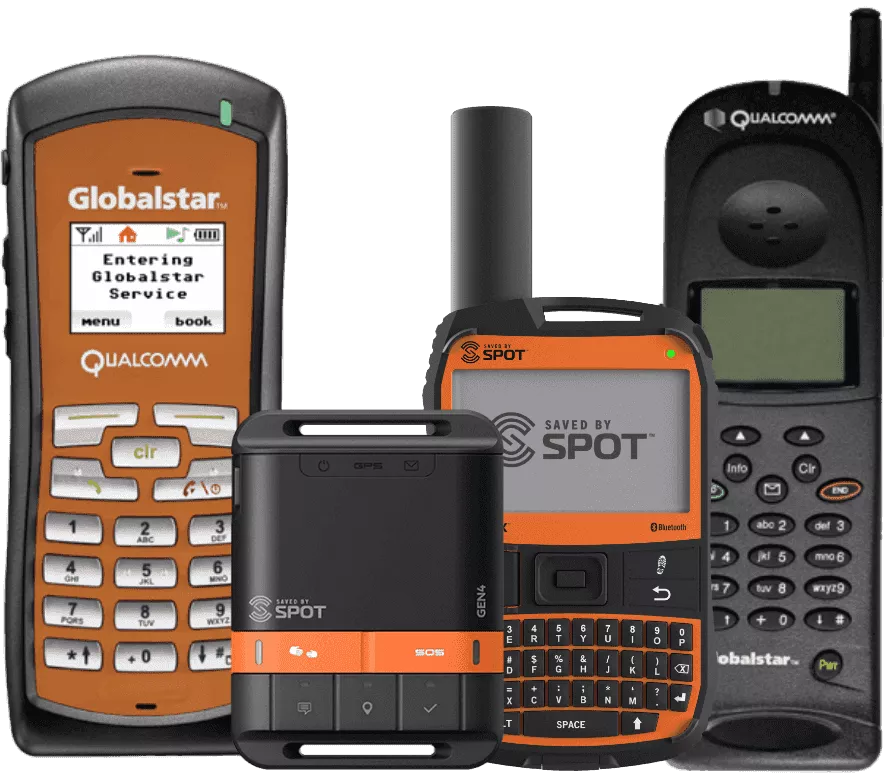 Globalstar's satellite phone terminal products satellite communications are also divided into satellite phone, SMS and satellite broadband Internet, with data transmission rates are disparate and have different hardware requirements. Satellite messaging requires much less transmission power than satellite calling.
Globalstar's satellite phone terminal products satellite communications are also divided into satellite phone, SMS and satellite broadband Internet, with data transmission rates are disparate and have different hardware requirements. Satellite messaging requires much less transmission power than satellite calling.
So, if the iPhone does support satellite communications, it will only likely be satellite messaging**, which means sending personal distress messages to emergency services and contacts when there is no network coverage in the user's area, and reporting crisis events (such as car accidents, boat accidents, plane crashes, fires, natural disasters, etc.) to the local authorities.
The 2021 blurb also mentions details such as text messages sent via satellite will show up as grey bubbles instead of blue and green bubbles; and distress messages sent will be pushed via satellite to emergency contacts' phones, so they can see them immediately even if they have DND Do Not Disturb mode on.
That said, satellite communication can only be used as a supplement to terrestrial communication when it's not available, and it can't be expected to enable calls or internet access, not to mention the odds that satellite calls will be cancelled or blocked on the country version of the iPhone 14. In the future, there may be an accompanying satcom case kit that acts as a high-powered antenna and extra battery to enable satellite calls, but for now, satellite messaging is still the feature we can look forward to the most.
So why exactly are satellite phones so strong, and what flaws affect their usability?
Advantages of satellite phones
Compared with ordinary mobile phones, the extreme environment coverage advantage of satellite phones is very obvious. The satellite phone achieves truly global communication and therefore has a wide range of applications, for example, it can be applied to maritime transportation, emergency rescue, scientific research, etc.
 Typical use scenario: Better Call Kim First of all, satellite communication can cover all areas of the earth's surface, independent of terrain, topography and other environmental factors. Even in sparsely populated areas such as deserts, plateaus, polar regions, and oceans, basic voice and data communication services can be achieved, making it possible to communicate without blind spots in the true sense.
Typical use scenario: Better Call Kim First of all, satellite communication can cover all areas of the earth's surface, independent of terrain, topography and other environmental factors. Even in sparsely populated areas such as deserts, plateaus, polar regions, and oceans, basic voice and data communication services can be achieved, making it possible to communicate without blind spots in the true sense.
The second is the long distance of satellite communications. Communication can be achieved between any location within the coverage of electromagnetic waves emitted by satellites, and communication satellites in geosynchronous orbit can achieve a communication distance of more than 18,000 km, with a single satellite covering up to 42.5 per cent of the Earth's surface area.
In addition, satellite communications have a large capacity. The frequency range is between 2 GHz and 40 GHz, and there are tens of thousands of voice communication channels and data transmission speeds of up to 100 Mbps. The bandwidth of satellites in the general C and Ku bands can reach 500-800 MHz, while the Ka band can reach several GHz.
Finally unaffected by adverse weather conditions such as ground disasters, satellite communications are an unparalleled and important means of communication in the face of earthquake relief or the failure of international submarine fibre optic cables.
Limitations of satellite phones
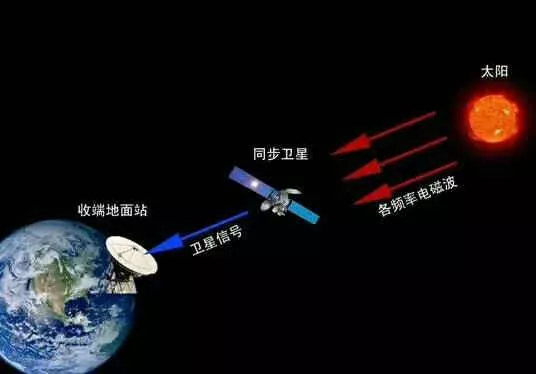 From February 25 to March 17, 2021, satellites used for the transmission of our broadcast television programs enter the spring sun-overcast period, and during the sun-overcast phenomenon Satellite TV users may see a mosaic of TV images or even signal interruptions but satellite telephony also has some limitations, many of which are related to communication satellites. The first is that communication satellites have a short lifespan. Because communication satellites are comprehensive high-tech products consisting of countless parts, any failure of a part will directly lead to the failure of the entire satellite, and because the cost of repair is too high, it is basically impossible to repair.
From February 25 to March 17, 2021, satellites used for the transmission of our broadcast television programs enter the spring sun-overcast period, and during the sun-overcast phenomenon Satellite TV users may see a mosaic of TV images or even signal interruptions but satellite telephony also has some limitations, many of which are related to communication satellites. The first is that communication satellites have a short lifespan. Because communication satellites are comprehensive high-tech products consisting of countless parts, any failure of a part will directly lead to the failure of the entire satellite, and because the cost of repair is too high, it is basically impossible to repair.
Secondly, satellite communications can be interfered by special celestial phenomena (such as solar-overcast phenomena and star eclipse and rain-decay phenomena), for example, when the satellite is between the Earth and the Sun and the three are in a straight line, the satellite antenna will be interfered by solar radiation and the ground station antenna will receive strong solar noise, causing communication interruptions.
This is immediately followed by the large propagation delay of radio waves and the presence of echo interference due to the long distance between the Earth and communication satellites, which may cause discomfort in calls and require special measures to counteract them.
In addition, the development, manufacture, launch, measurement and control of communication satellites require advanced space and electronic technologies and are very complex. With a satellite launch success rate of 80 per cent and a lifetime of several to a dozen years, the development of satellite communications requires long-term planning and the risk of launch failure.
Also, high latitudes can have a shielding effect on the reflection, refraction, and diffraction of electromagnetic waves used for communication, so communication in these areas is not effective.
Finally, in geosynchronous satellite communication systems, the distance from the communication station to the synchronous satellite can be up to 40,000 km, and electromagnetic waves take about 0.27 seconds each way when transmitted at the speed of light, resulting in a large transmission delay and making the call experience very bad.
Current status of satellite communications development
Besides the rumored Globalstar, what other satellite communication systems are out there?
The current mainstream satellite communication systems are Iridium, Maritime, Eurostar and Antenna, which can be divided into two categories: near-Earth orbit satellite systems (LEO) and geosynchronous orbit satellite systems (GSO).
The advantage of near-Earth orbit (LEO) satellite technology is that it provides seamless global wireless signal coverage. Satellites in near-Earth orbit operate at high speeds (one orbit around the Earth every 70 to 90 minutes) in lower orbits (640 to 1120 km), but therefore also require more satellites to maintain signal coverage.
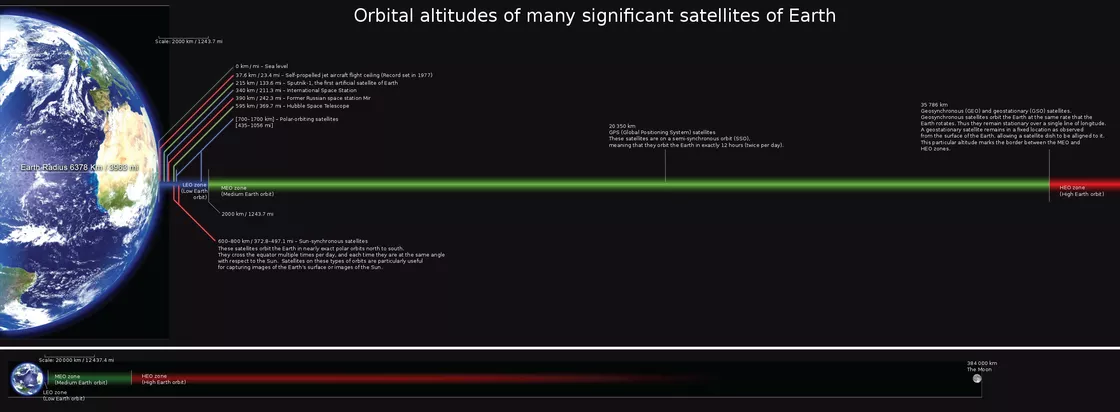 LEO, MEO, GSO Orbital distance distribution from Earth while the Geosynchronous Satellite Orbit (GSO) system requires only three to four satellites to maintain nearly all-weather global signal coverage, thus reducing the cost of launching satellites. However, such satellites tend to be very heavy (about 5 tons), making the construction and launch of individual satellites more costly. Satellites in geosynchronous orbit operate at an altitude of about 35,000 km, so the delay in making calls or transmitting other data is significant.
LEO, MEO, GSO Orbital distance distribution from Earth while the Geosynchronous Satellite Orbit (GSO) system requires only three to four satellites to maintain nearly all-weather global signal coverage, thus reducing the cost of launching satellites. However, such satellites tend to be very heavy (about 5 tons), making the construction and launch of individual satellites more costly. Satellites in geosynchronous orbit operate at an altitude of about 35,000 km, so the delay in making calls or transmitting other data is significant.
Another drawback of the geosynchronous orbit system is that even if the user is in a very open area, the signal from the satellite phone may be blocked by a steep slope or a forest in one direction, so the user has to go to higher ground to get the signal.
This problem does not exist for network services in near-Earth orbit, because even if the current satellite signal is blocked by an obstacle, a new satellite will fly over the user's location from another direction in a few minutes.
Near Earth orbit satellites (LEO)
The best-known satellites in near-Earth orbit are Iridium and Globalstar, the subject of this rumor, and Elon Musk's Starlink (https://www.starlink.com/), which also operates in near-Earth orbit and is expected to have up to 12,000 satellites, but it is not relevant to this article and is too well known to be described in detail. It is not relevant to this paper and is too well known to be described in detail.
 SpaceX Starlink Satellite Internet Receiver Antenna #### Iridium
SpaceX Starlink Satellite Internet Receiver Antenna #### Iridium
The Iridium system was conceived in the 1990s and began service on November 1, 1998. However, there was not enough demand in the market at that time and it was restructured in 1999.
The Iridium project also became the starting point of Motorola's decline. Due to the lack of R&D funds and too much involvement in the field, Motorola's CPU business and DSP business were later chosen to be sold. Due to the lack of investment in GSM, Motorola did not master the core network technology such as programmed switching for a long time, and could not set up network independently, which also led to the loss of Motorola's market in the field of communication equipment, coupled with the low price invasion of ZTE and Huawei and the loss of WiMax, Motorola's base station business eventually collapsed.
The current Iridium, in fact, is in its second generation, with all 66 of the first generation having crashed into the atmosphere by December 2019.
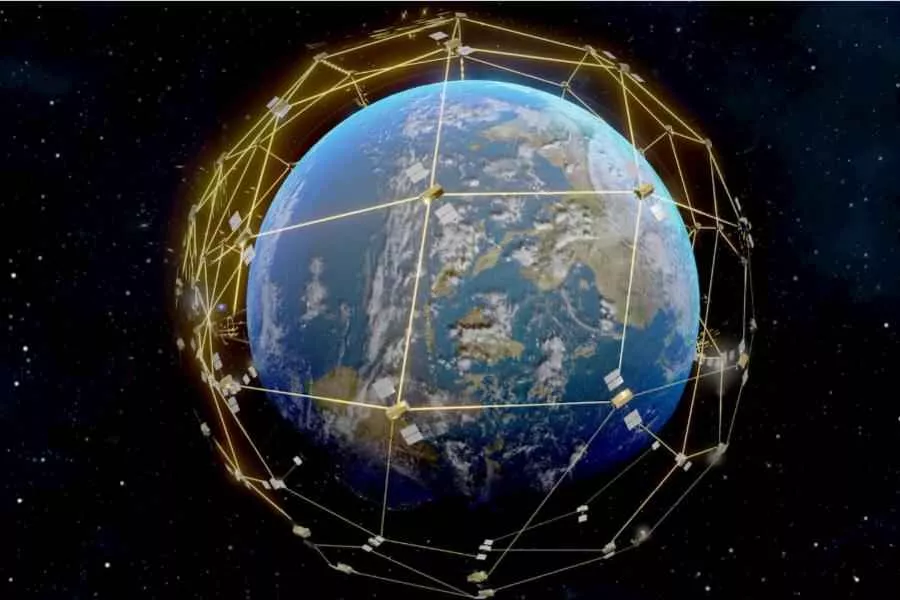 The second generation of Iridium has 75 satellites (66 active + 9 in-orbit backup) deployed in 780 km altitude operational orbits, capable of L-band voice and data communications using 48-beam phased array antennas. Compared to the first generation, the second generation Iridium has double the constellation lifetime, upgraded the number of supported connections to 1900+, increased processing power of the on-board computer, and expanded the inter-satellite link bandwidth by nearly 3 times to 17 Mbps and the feeder link bandwidth by 10 times to 30 Mbps.
The second generation of Iridium has 75 satellites (66 active + 9 in-orbit backup) deployed in 780 km altitude operational orbits, capable of L-band voice and data communications using 48-beam phased array antennas. Compared to the first generation, the second generation Iridium has double the constellation lifetime, upgraded the number of supported connections to 1900+, increased processing power of the on-board computer, and expanded the inter-satellite link bandwidth by nearly 3 times to 17 Mbps and the feeder link bandwidth by 10 times to 30 Mbps.
Iridium's data relay is a relay that delivers data to the nearest ground station through a signal transmission between satellites. Iridium achieves truly global coverage, including the North and South Poles. Typical Iridium satellite users include mariners, aviators, government agencies, the petrochemical industry, scientists and frequent travelers.
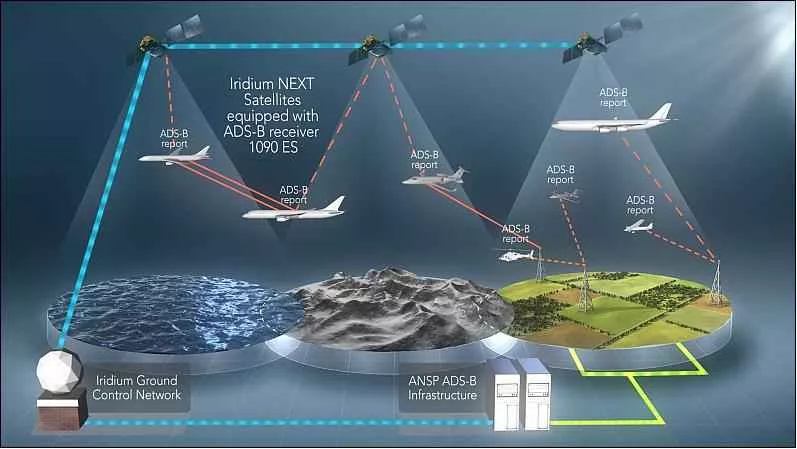 Iridium satellites communicate at only 2400 baud per second, so voice data must be compressed significantly and there is a significant 500ms delay in voice. Garmin's emergency satellite communications service InReach also uses Iridium satellites.
Iridium satellites communicate at only 2400 baud per second, so voice data must be compressed significantly and there is a significant 500ms delay in voice. Garmin's emergency satellite communications service InReach also uses Iridium satellites.
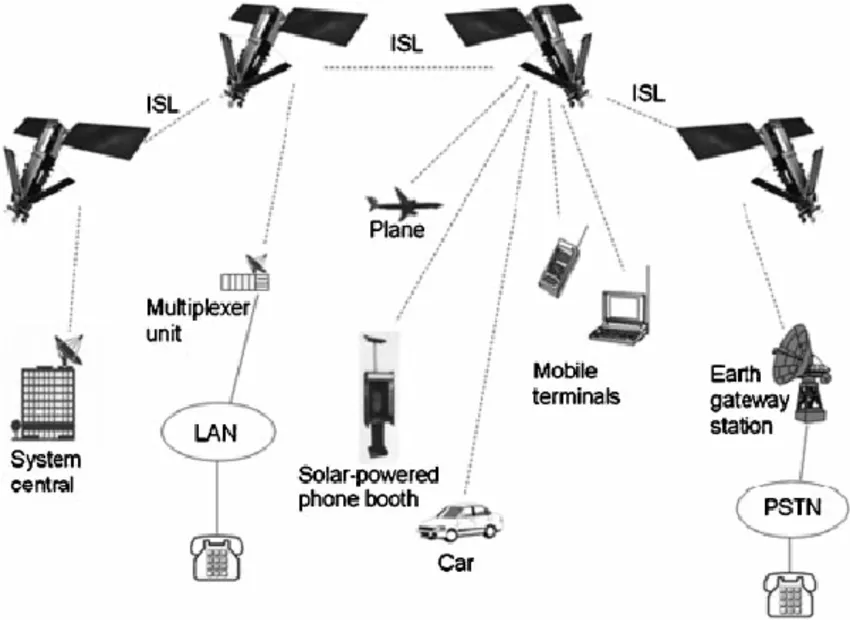 Iridium system relay schematic #### Globalstar
Iridium system relay schematic #### Globalstar
Similar to Iridium, the main difference is the relay mechanism. It is also currently a second-generation satellite constellation, consisting of 24 LEO satellites and 24 ground stations. Each satellite must have at least one ground receiving station within signal range, so its network is not actually available in many areas. The satellites operate in a 52-degree inclined orbit, so there is also no signal at the poles.
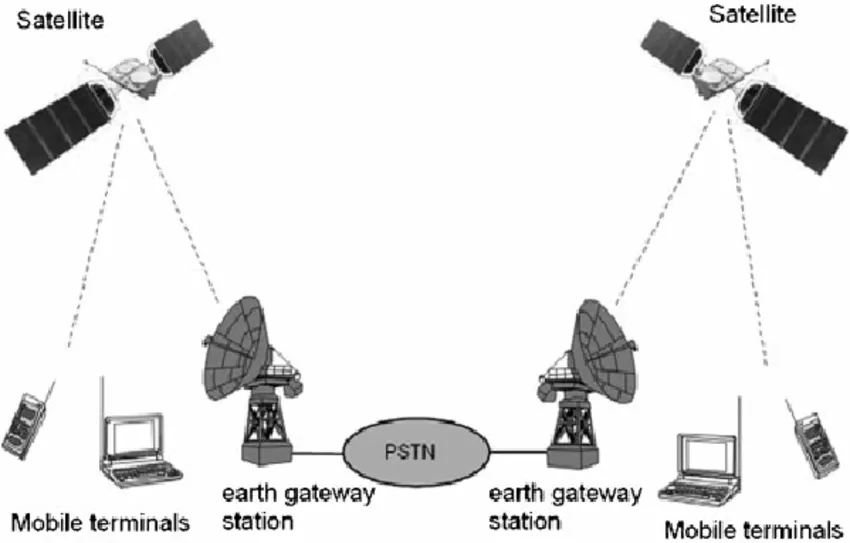 Globalstar System Relay Schematic### Geosynchronous Earth Orbit (GSO) Satellites
Globalstar System Relay Schematic### Geosynchronous Earth Orbit (GSO) Satellites
Maritime (Inmarsat)
Inmarsat, or simply Maritime (Inmarsat), is a British satellite communications company that provides a global mobile service. It first originated in 1979 as Inmarsat, a not-for-profit international organization established under the authority of the United Nations International Maritime Organization agency to provide a satellite communications network for the shipping community to enhance the safety of human life at sea.
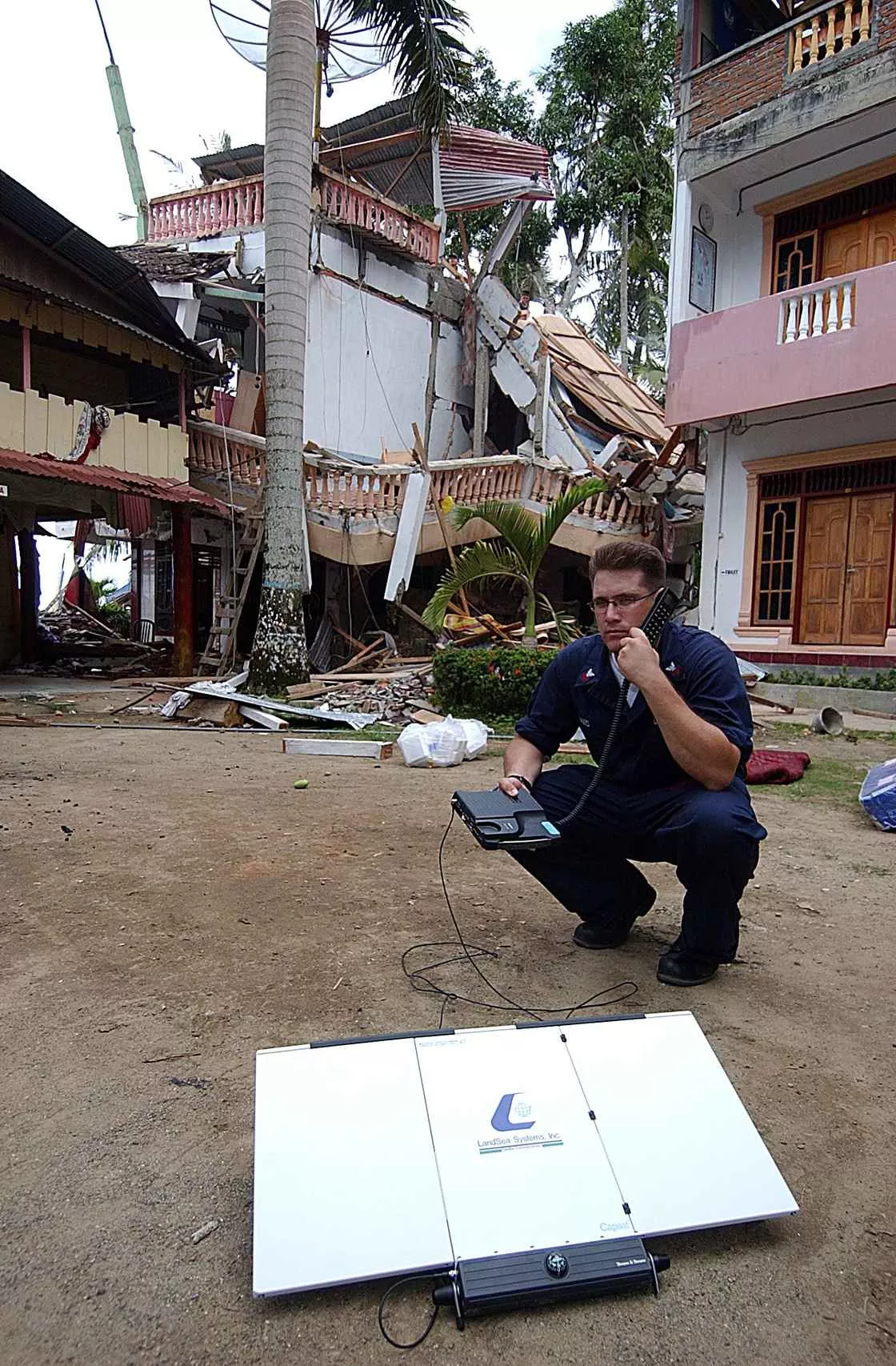 Maritime's satellite phones in real-world applications in disaster relief, see how big this antenna is #### Eurostar (Thuraya)
Maritime's satellite phones in real-world applications in disaster relief, see how big this antenna is #### Eurostar (Thuraya)
Thuraya is a UAE-based communications company that operates two geosynchronous orbiting satellites and provides telecommunications coverage in 161 countries in Europe, the Middle East, North Africa, Central and East Africa, Asia and Australia.
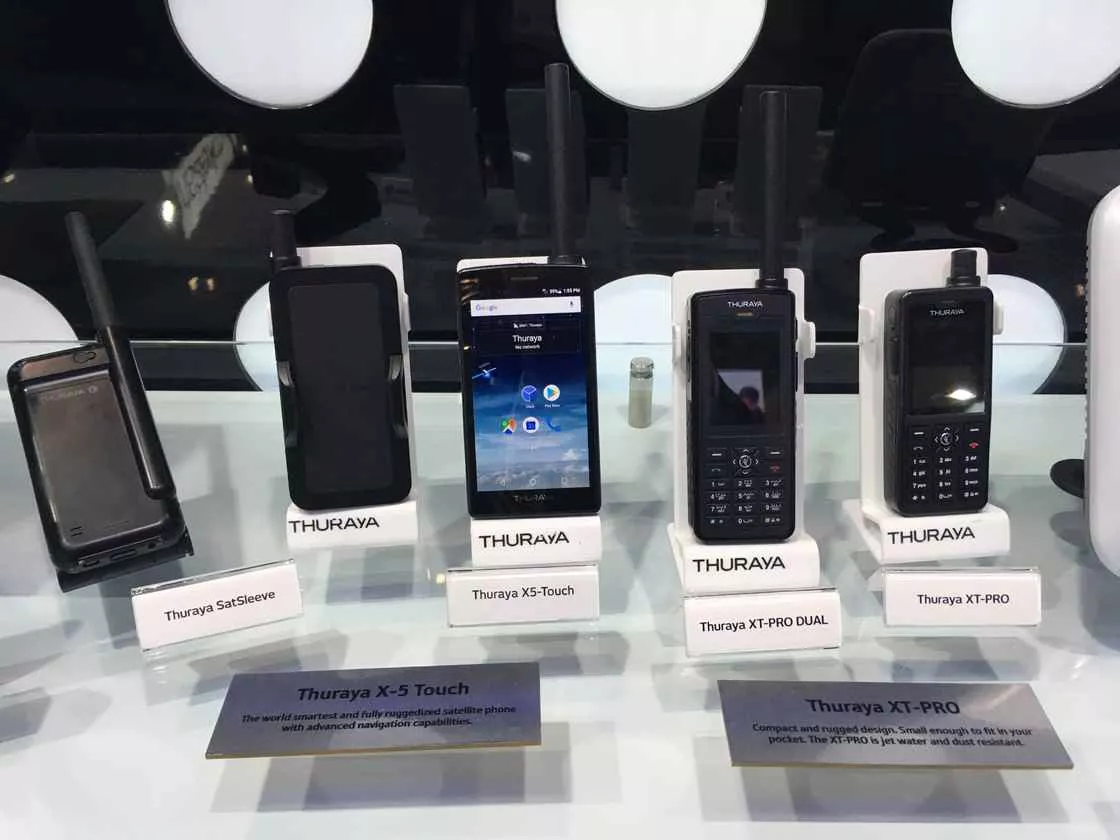 Thuraya Mobile #### Antenna Satellite
Thuraya Mobile #### Antenna Satellite
After the Wenchuan earthquake in 2008, China launched the development of Tiantong-1 satellite in order to have its own mobile communication satellite system.In 2016, the S-band high-capacity geosynchronous orbit mobile communication satellite Tiantong-1 01 was successfully launched, realizing the breakthrough of zero mobile communication satellite in China.In 2020, the 02 satellite was successfully launched, and the 03 satellite was successfully launched in 2021.
The Tiantong-1 satellite mobile communication system, consisting of a space segment, a ground segment and user terminals, with the space segment planned to consist of a number of geosynchronous orbit mobile communication satellites. The coverage area is mainly China and the surrounding areas, the Middle East, Africa and other related regions, as well as most of the waters of the Pacific Ocean and the Indian Ocean.
 If iPhone 14 does support satellite communication, of course the likelihood of it landing in China because of policies, licenses and other reasons is slim, but Huawei Xiaomi OV and other domestic phone manufacturers will most likely seek a similar solution, then it would seem logical to work with Antenna.
If iPhone 14 does support satellite communication, of course the likelihood of it landing in China because of policies, licenses and other reasons is slim, but Huawei Xiaomi OV and other domestic phone manufacturers will most likely seek a similar solution, then it would seem logical to work with Antenna.
tail
What do you feel after reading all the basics of the satellite? If, as rumored, Globalstar bought 17 new satellites for this partnership, and has to launch and build ground stations, the cost should not be too high. And considering the base of users who will buy the service, the cost per user will probably be quite high. If it's still only available on iPhone 14 or even 14 Pro models, that's too little, too little.
So, given that the M1 Max chip was released without any mention of its expandability, while some enthusiasts speculated that it might support dual-chip connectivity based on DieShot, it wasn't confirmed until the M1 Ultra was released. So maybe the hardware needed for satellite communications was already built into the iPhone 13 series (but didn't end up with the X65 baseband, but a magically modified X60) and won't be enabled until the 14 release when it's announced that the upgrade to iOS 16 will be available.
This makes sense personally to have two generations of iPhones that can escort support for the service when it is released, and the 13 generation is still in a strong demand cycle with huge sales and retention.
The answer will be revealed in four months, or perhaps every April Mark Gurman will have a new article revealing that iPhone 15 will soon support satellite messaging, so stay tuned.